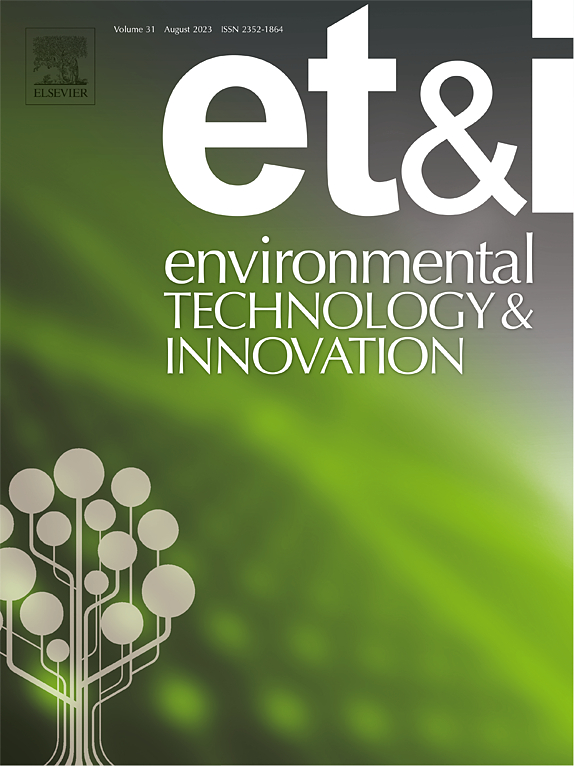IF 6.7
2区 环境科学与生态学
Q1 BIOTECHNOLOGY & APPLIED MICROBIOLOGY
引用次数: 0
摘要
酚羟基(ArOH)在腐植酸(HA)提高氮肥效率方面发挥着重要作用。然而,腐植酸中 ArOH 的含量通常较低,而传统的富集改性方法效率不高,甚至存在潜在的毒性风险。在这项工作中,我们开发了一种富含中孔和氧空位的新型催化剂 CuO@Al2O3,并采用可行的机械催化方法对 HA 进行靶向改性,以提高其 ArOH 含量。结果表明,成功制备出富含酚的 HA(CuO@Al2O3-HA),其 ArOH 含量比 HA 高 40%,这与 XPS C1s 光谱中 C-O/Ar-O 含量增加 43.13% 相一致。与 RHA 相比,CuO@Al2O3-HA 的单宁含量更低,这归因于 CuO@Al2O3 催化 Ar-C 键断裂形成 ArOH。随后,我们制备了 CuO@Al2O3-HA 增强尿素(CuO@Al2O3-HAU),发现 CuO@Al2O3-HAU 通过提高叶片叶绿素含量(8.78 %)和抑制 NH3 挥发降低氮素损失(12.43 %),因此与 RHA 增强尿素(RHAU)相比,玉米幼苗的生物量和氮素吸收量分别提高了 11.29 % 和 21.22 %。因此,本研究提供了一种富集 HA 中 ArOH 含量的方法,为高效尿素产品的升级提供了一种绿色途径。本文章由计算机程序翻译,如有差异,请以英文原文为准。
Targeted fortification of phenolic hydroxyl groups in humic acid to further enhance urea use efficiency in maize seedling
Phenolic hydroxyl group (ArOH) plays an important role in humic acid (HA) enhancing nitrogen (N) fertilizer efficiency. However, the content of ArOH in HA is usually low, while its traditional enriching modification are inefficient or even showed a potential toxicity risk. In this work, we developed a novel catalyst named CuO@Al2O3 enriched with mesopores and oxygen vacancies, and target-modified HA to increase its ArOH using a feasible mechanical catalytic method. The results showed that phenolic-rich HA (CuO@Al2O3-HA) were successfully prepared with 40 % higher ArOH content than HA, which was consistent with the 43.13 % increase in C-O/Ar-O content in XPS C1s spectra. Compared to RHA, CuO@Al2O3-HA had less tannin attributed to the Ar-C bond breakage catalyzed by CuO@Al2O3 to form ArOH. Subsequently, we prepared CuO@Al2O3-HA-enhanced urea (CuO@Al2O3-HAU), and found that CuO@Al2O3-HAU improved maize seedling growth by the elevation of leaf chlorophyll content (by 8.78 %) and lowering N loss by NH3 volatilization inhibition (by 12.43 %), thus enhanced the biomass and N uptake of maize seedling by 11.29 % and 21.22 %, respectively, compared to RHA-enhanced urea (RHAU). Therefore, this study provided a method to enrich the ArOH content of HA, and a green approach for the upgrading of high-efficiency urea products.
求助全文
通过发布文献求助,成功后即可免费获取论文全文。
去求助
来源期刊

Environmental Technology & Innovation
Environmental Science-General Environmental Science
CiteScore
14.00
自引率
4.20%
发文量
435
审稿时长
74 days
期刊介绍:
Environmental Technology & Innovation adopts a challenge-oriented approach to solutions by integrating natural sciences to promote a sustainable future. The journal aims to foster the creation and development of innovative products, technologies, and ideas that enhance the environment, with impacts across soil, air, water, and food in rural and urban areas.
As a platform for disseminating scientific evidence for environmental protection and sustainable development, the journal emphasizes fundamental science, methodologies, tools, techniques, and policy considerations. It emphasizes the importance of science and technology in environmental benefits, including smarter, cleaner technologies for environmental protection, more efficient resource processing methods, and the evidence supporting their effectiveness.
 求助内容:
求助内容: 应助结果提醒方式:
应助结果提醒方式:


